- Joined
- Mar 5, 2019
- Messages
- 11,137
- Points
- 113
from scmp :
In rich Singapore, why must migrant workers go hungry?
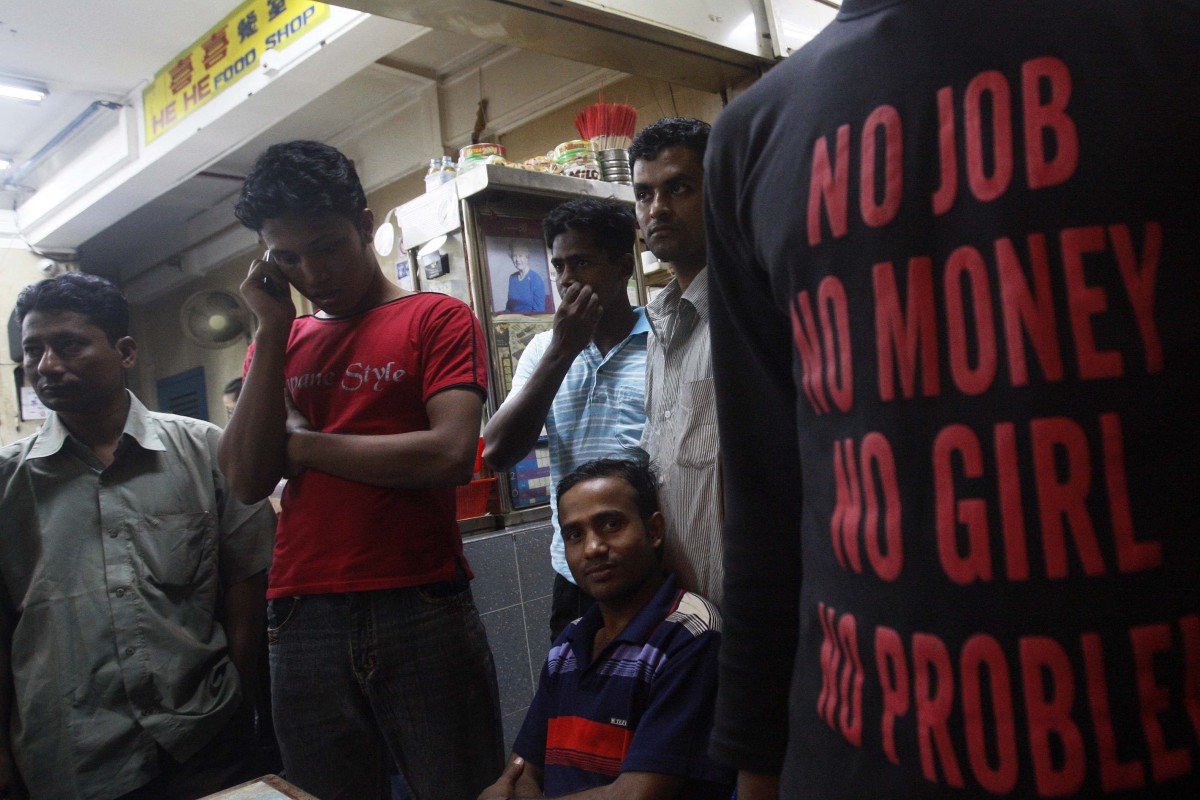
Labourers from Bangladesh at a coffee shop in Singapore’s Little India district. Photo: Reuters
Whenever Mominul Hassan calls his wife and two children back home in Bangladesh, he makes it a point to disable the video call function on his phone so that they will not be able to see him.
This, he says, is the only way to ensure that they never find out how much weight he has lost since coming to work in
Singapore
as a construction worker eight years ago.
“If my wife sees me, she will worry and ask me to come home. I miss home but I also need to earn enough money before I can return,” he said.
Hassan, 32, weighed 65kg when he arrived here. Today, he is only 55kg – a dip caused by a lack of proper food and nutrition, he said.
Domestic workers are the slaves of modern Asia. Are Hongkongers, Singaporeans and Malaysians ever going to change?
Hassan is not alone. In one of Asia’s most developed countries, where food wastage is a national problem, migrant workers are going hungry because of low wages and a highly competitive food catering industry that capitalises on the willingness of workers to scrimp and save for a better life.
By registering for these newsletters you agree to our T&C and Privacy Policy
World renowned for its meticulously planned cities and distinct skyline that featured in the Hollywood hit film Crazy Rich Asians, Singapore depends on a large pool of blue collar migrant workers from countries like
India
, Bangladesh and Myanmar to power its building and construction sector, which was valued at nearly US$22.5 billion in 2018.
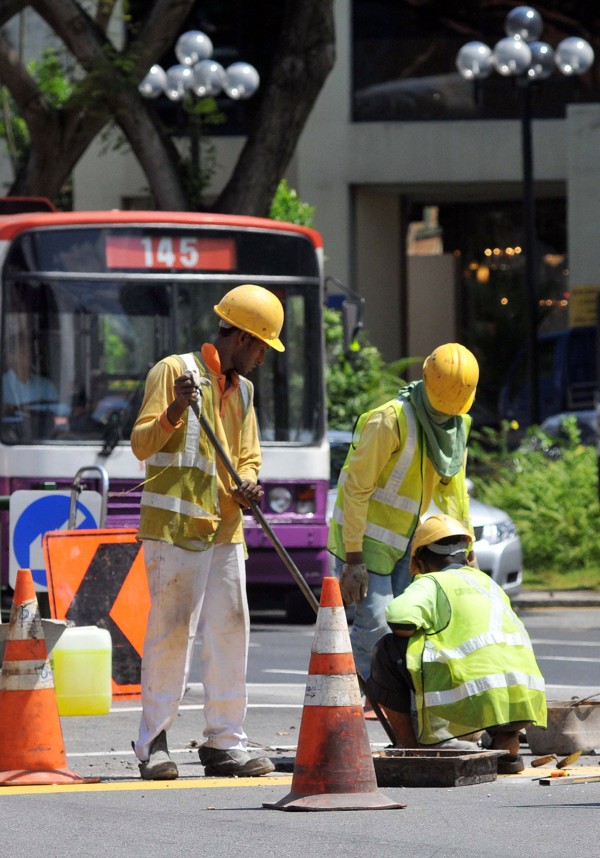
Migrant workers in Singapore typically make about US$15 a day – and work up to 12 hours a day. Photo: AFP
Share:
But in a country with no minimum wage, migrant workers take home just US$13-15 daily for back breaking work that usually lasts from 10 to 12 hours a day, depending on the scale of the project.
As a result, most workers do not mind clocking in extra overtime hours to supplement their income.
With barely enough time and cash to spare, they turn to caterers as a no-frills and cheap solution for their daily meals.
On paper, it seems a good deal. For US$90-US$110 a month, they get three meals a day delivered straight to their dormitories and work sites.
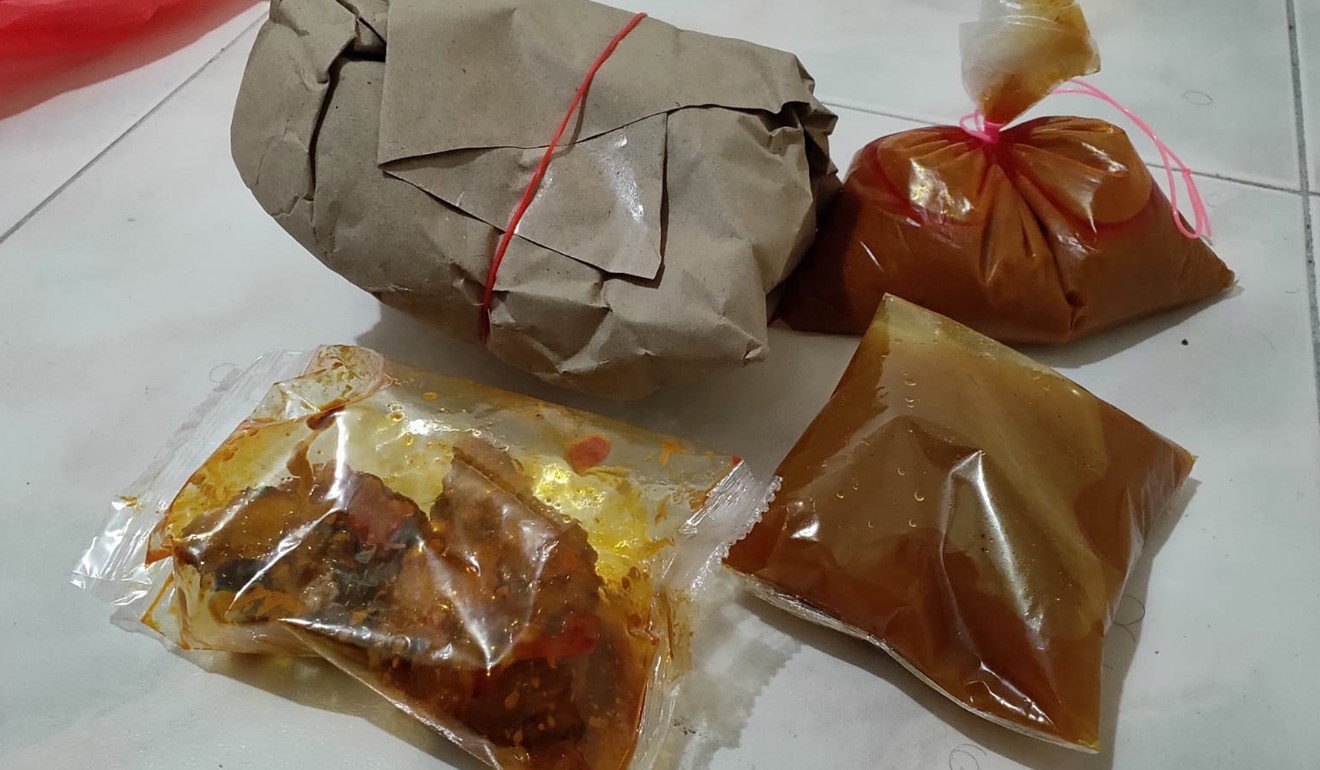
Catered meals for migrant workers usually consist of a portion of rice accompanied by a portion of meat and a side of vegetables. Photo: Prabhu Silvam
Share:
But in reality, the food served is paltry, nutritionally insufficient and sometimes downright rotten.
A typical breakfast consists of two to three pieces of flat breads like paratha or chapatti with a side of dhal, or lentil, curry. For lunch and dinner, workers are served white rice and curry accompanied by one portion of meat and a side of vegetables.
The invisible struggle: how thousands of female migrant workers lose their money and their children every year
Even though the food is prepared from scratch, it becomes unappetising or stale by the time it reaches workers because caterers often cut back on logistics to fatten profit margins.
While a typical work day for a migrant worker begins as early as 7am, it is common for caterers to deliver both breakfast and lunch parcels together by 6am to avoid making double trips.
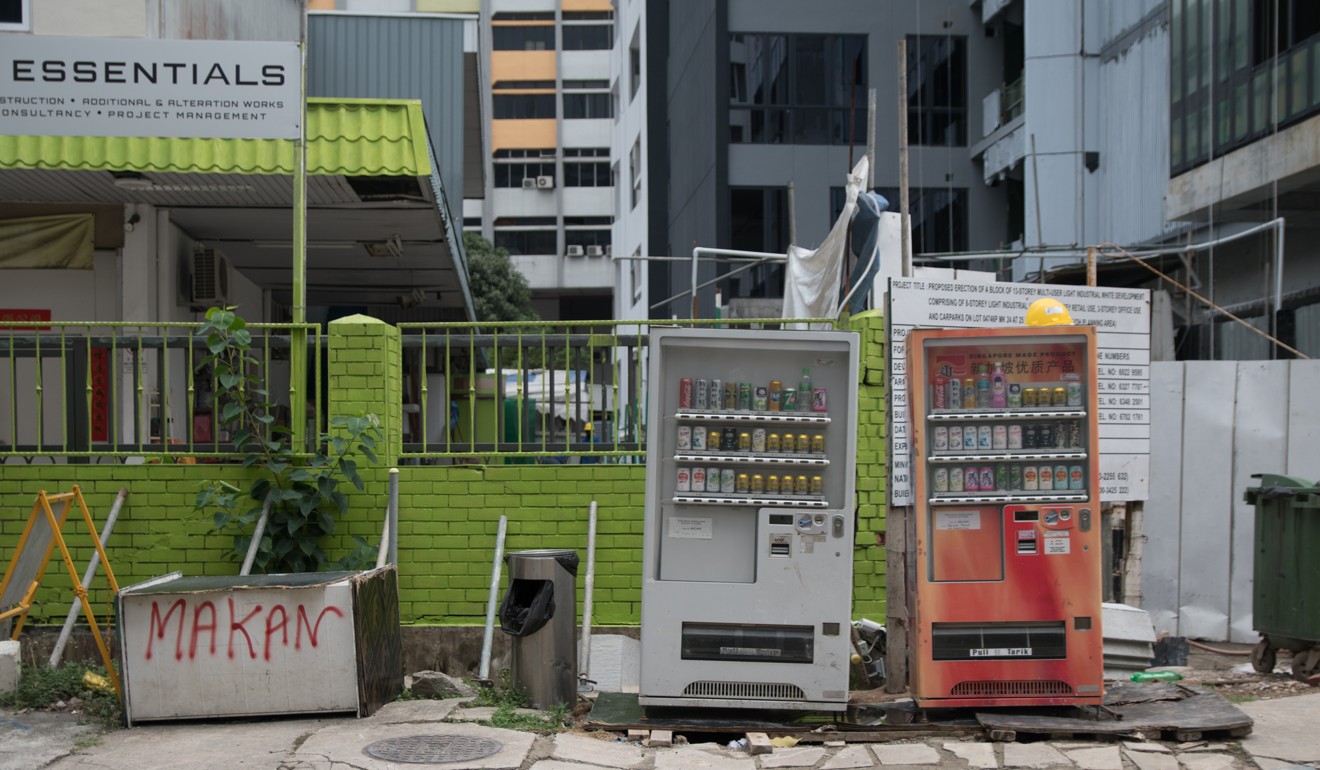
A food storage box outside a construction site in Singapore. Photo: Prabhu Silvam
Share:
This is despite the national food safety body requiring caterers to provide a time-stamp for pre-packed and catered meals indicating a recommended “consume by” time – typically four hours from the time a dish is cooked.
Caterers usually adhere to the rule, indicating the correct time stamp. But they know the workers are unable to eat until much later.
What this means is that by lunch time, workers often end up having to eat food that was probably prepared six to eight hours ago.

A migrant worker on a construction site in Singapore. Many such workers pay about US$100 a month to catering services that deliver all their meals. File photo
Share:
Exposed to Singapore’s heat and humidity, the food often succumbs quickly in the open.
“The food always arrives fresh but by the time I eat it, it has already become bad. Usually I will throw away about half of the rice because I cannot eat it any more,” said Hassan.
Ironically, the workers are also contributing to Singapore’s food waste problem.
LACK OF STORAGE
The food packages are usually left in boxes in the open, because there is a lack of proper food storage areas near dormitories and work sites.
As a result, workers told This Week in Asia it is not uncommon to find stray dogs and rats getting to the food packets before them. During months of monsoon rain, the food is soaked and inedible.
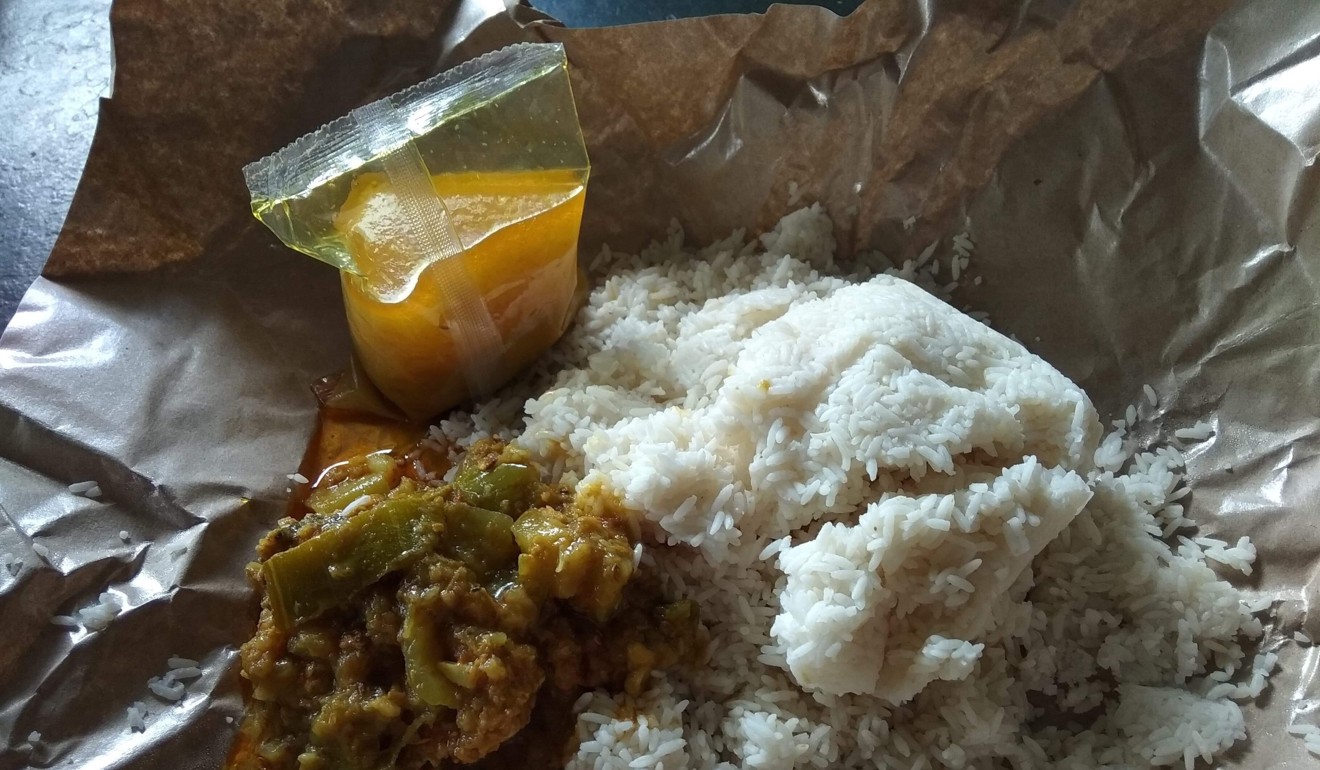
A Bangladeshi worker’s lunch meal comprising of rice served with a side of stewed vegetables and curry. Photo: Prabhu Silvam
Share:
To get by, workers often forgo meals altogether. Others turn to caffeine-enhanced energy drinks to perk themselves up and to eliminate hunger pangs.
Indian national A. Rajah, who has lived in Singapore for seven years, says that even though he is well aware of the long-term side effects of energy drinks, such as increased blood pressure and diabetes, he has little choice.
Migrant workers’ cases in Singapore more shocking than in Hong Kong, photographer claims
“It’s cheap and the sweet aftertaste helps to keep me awake,” he said. “But I’m not the only one. If you wait outside worker dormitories in the morning, you will see piles of energy drink cans.”
For workers who live in dormitories equipped with adequate cooking facilities, the situation is only slightly better. While they can cook their own meals, the supermarkets in dormitories usually charge higher prices for their goods compared to those elsewhere.
“The nearest supermarket is very far away and by the time we all get back at the end of the day, we are all very tired,” said R. Velmurugan, from India.
“Every minute that we get to rest is important so we have no choice but to buy from the supermarket in the dorm even though it is expensive.”
CATERERS struggle, too
With 1.5 million foreign workers in Singapore, the food catering business that serves them is lucrative. To edge ahead, firms slash prices knowing the customers are very price sensitive. Quality invariably suffers.
“Similar to any other industry, the more you pay, the better the quality. It is not the fault of the caterers or the workers,” said Sukkur Maideen, 47, who manages a canteen and a supermarket at a dormitory.
Caterers do not have it easy either. To meet demand, kitchen operations run 24 hours a day, every day of the year. The labour intensive business chalks up heavy costs for logistics, fuel and manpower and Singapore is expensive. Margins are thin.
A seasoned industry player says caterers make just 30 cents per meal. To boost profits, corners are cut by using inferior ingredients and consolidating deliveries.
One caterer said workers could not expect more for the amount they paid. His company serves 4,000 workers three meals a day, charging each worker US$105 per month. This works out to around US$1.20 a meal.
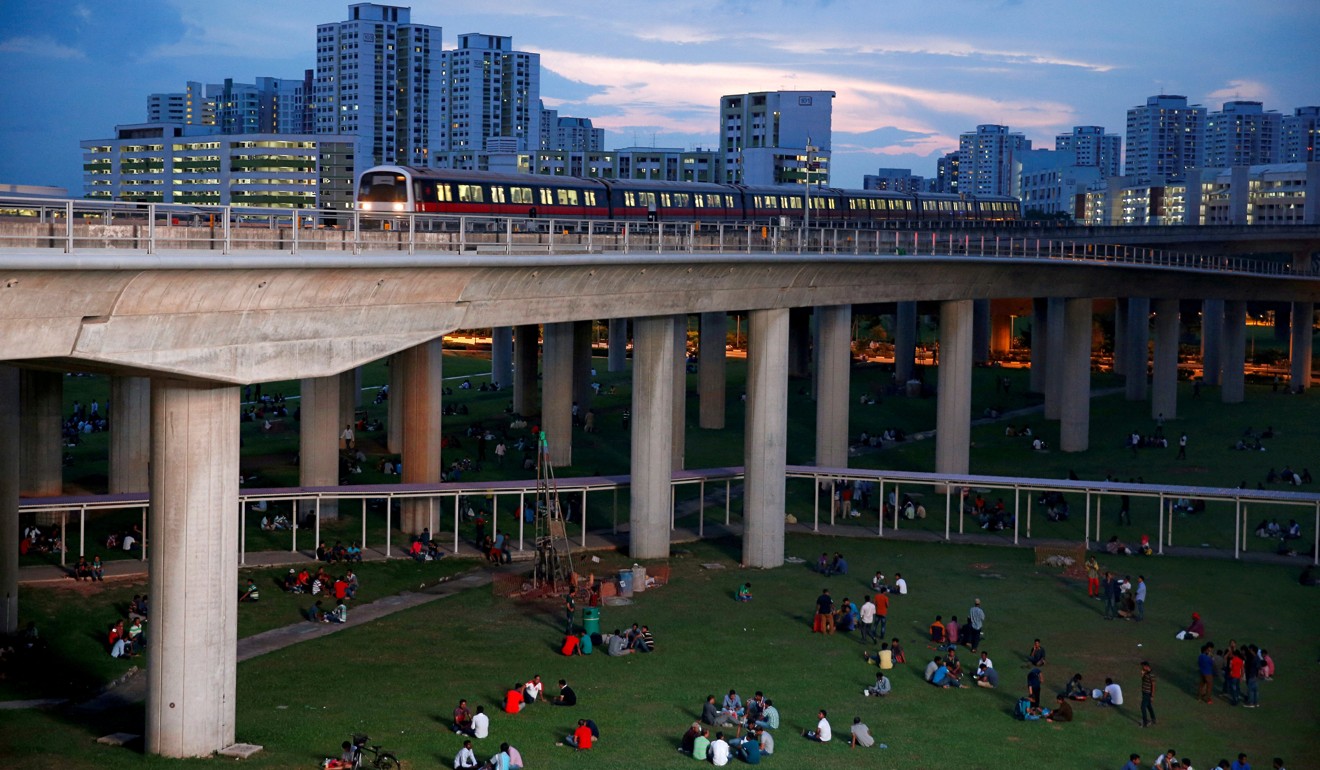
Migrant workers from Bangladesh and India gather near a train station in Singapore on their day off. Photo: Reuters
Share:
“Where else in Singapore can you find a meal with one meat, one vegetable and rice for that amount?” he said. A similar meal in a hawker centre in Singapore would be twice as expensive. “Workers are put in a tough place because they cannot afford much. At the same time, we are running a business here so there are certain targets to meet,” he said.
But social worker Luke Tan said caterers were taking advantage.
“Low wages mean that workers have no choice but to spend as little amount as possible on their food if they want to send money back home. They are willing to forgo their rights and sacrifice their heath for a better life so this makes them ripe for exploitation,” said the operations manager at the Home Organisation for Migration Economics.
“With 1.5 million migrant workers in Singapore, exploitation becomes a lucrative market.”
Migrant worker T. Kamalakannan, 26, suggested using weatherproof thermal food boxes could improve the situation.
Anger at Singapore ads offering Indonesian domestic helpers for ‘sale’
“Proper storage boxes that can help to keep our food warm and safe will give us peace of mind because we can work knowing that we don’t have to go hungry or throw away our food afterwards,” he said.
The food issue, said migrant worker activist Debbie Fordyce, executive committee member at Transient Workers Count Too, was part of a wider picture of exploitation facing low wage transient migrant workers. After having to pay exorbitant recruitment fees to secure their – often dangerous and demeaning – jobs, workers were indebted to a point where coercion and exploitation was inevitable, said Fordyce.
She said employers had a responsibility to ensure their workers had access to reliable caterers or adequate kitchen facilities to prepare their own meals. “Migrant workers play a key role in driving or economy. We should treat foreign workers humanely, not as disposable and replaceable labour,” she said. ■
In rich Singapore, why must migrant workers go hungry?
- The labourers who build the gleaming skyline made famous in Crazy Rich Asians are paid as little as US$15 a day for 12 hour shifts, meaning they have little choice but to turn to low cost caterers to provide their meals
- Unfortunately, the food served is often paltry, nutritionally insufficient and sometimes downright rotten

Labourers from Bangladesh at a coffee shop in Singapore’s Little India district. Photo: Reuters
Whenever Mominul Hassan calls his wife and two children back home in Bangladesh, he makes it a point to disable the video call function on his phone so that they will not be able to see him.
This, he says, is the only way to ensure that they never find out how much weight he has lost since coming to work in
Singapore
as a construction worker eight years ago.
“If my wife sees me, she will worry and ask me to come home. I miss home but I also need to earn enough money before I can return,” he said.
Hassan, 32, weighed 65kg when he arrived here. Today, he is only 55kg – a dip caused by a lack of proper food and nutrition, he said.
Domestic workers are the slaves of modern Asia. Are Hongkongers, Singaporeans and Malaysians ever going to change?
Hassan is not alone. In one of Asia’s most developed countries, where food wastage is a national problem, migrant workers are going hungry because of low wages and a highly competitive food catering industry that capitalises on the willingness of workers to scrimp and save for a better life.
By registering for these newsletters you agree to our T&C and Privacy Policy
World renowned for its meticulously planned cities and distinct skyline that featured in the Hollywood hit film Crazy Rich Asians, Singapore depends on a large pool of blue collar migrant workers from countries like
India
, Bangladesh and Myanmar to power its building and construction sector, which was valued at nearly US$22.5 billion in 2018.

Migrant workers in Singapore typically make about US$15 a day – and work up to 12 hours a day. Photo: AFP
Share:
But in a country with no minimum wage, migrant workers take home just US$13-15 daily for back breaking work that usually lasts from 10 to 12 hours a day, depending on the scale of the project.
As a result, most workers do not mind clocking in extra overtime hours to supplement their income.
With barely enough time and cash to spare, they turn to caterers as a no-frills and cheap solution for their daily meals.
On paper, it seems a good deal. For US$90-US$110 a month, they get three meals a day delivered straight to their dormitories and work sites.

Catered meals for migrant workers usually consist of a portion of rice accompanied by a portion of meat and a side of vegetables. Photo: Prabhu Silvam
Share:
But in reality, the food served is paltry, nutritionally insufficient and sometimes downright rotten.
A typical breakfast consists of two to three pieces of flat breads like paratha or chapatti with a side of dhal, or lentil, curry. For lunch and dinner, workers are served white rice and curry accompanied by one portion of meat and a side of vegetables.
The invisible struggle: how thousands of female migrant workers lose their money and their children every year
Even though the food is prepared from scratch, it becomes unappetising or stale by the time it reaches workers because caterers often cut back on logistics to fatten profit margins.
While a typical work day for a migrant worker begins as early as 7am, it is common for caterers to deliver both breakfast and lunch parcels together by 6am to avoid making double trips.

A food storage box outside a construction site in Singapore. Photo: Prabhu Silvam
Share:
This is despite the national food safety body requiring caterers to provide a time-stamp for pre-packed and catered meals indicating a recommended “consume by” time – typically four hours from the time a dish is cooked.
Caterers usually adhere to the rule, indicating the correct time stamp. But they know the workers are unable to eat until much later.
What this means is that by lunch time, workers often end up having to eat food that was probably prepared six to eight hours ago.

A migrant worker on a construction site in Singapore. Many such workers pay about US$100 a month to catering services that deliver all their meals. File photo
Share:
Exposed to Singapore’s heat and humidity, the food often succumbs quickly in the open.
“The food always arrives fresh but by the time I eat it, it has already become bad. Usually I will throw away about half of the rice because I cannot eat it any more,” said Hassan.
Ironically, the workers are also contributing to Singapore’s food waste problem.
LACK OF STORAGE
The food packages are usually left in boxes in the open, because there is a lack of proper food storage areas near dormitories and work sites.
As a result, workers told This Week in Asia it is not uncommon to find stray dogs and rats getting to the food packets before them. During months of monsoon rain, the food is soaked and inedible.

A Bangladeshi worker’s lunch meal comprising of rice served with a side of stewed vegetables and curry. Photo: Prabhu Silvam
Share:
To get by, workers often forgo meals altogether. Others turn to caffeine-enhanced energy drinks to perk themselves up and to eliminate hunger pangs.
Indian national A. Rajah, who has lived in Singapore for seven years, says that even though he is well aware of the long-term side effects of energy drinks, such as increased blood pressure and diabetes, he has little choice.
Migrant workers’ cases in Singapore more shocking than in Hong Kong, photographer claims
“It’s cheap and the sweet aftertaste helps to keep me awake,” he said. “But I’m not the only one. If you wait outside worker dormitories in the morning, you will see piles of energy drink cans.”
For workers who live in dormitories equipped with adequate cooking facilities, the situation is only slightly better. While they can cook their own meals, the supermarkets in dormitories usually charge higher prices for their goods compared to those elsewhere.
“The nearest supermarket is very far away and by the time we all get back at the end of the day, we are all very tired,” said R. Velmurugan, from India.
“Every minute that we get to rest is important so we have no choice but to buy from the supermarket in the dorm even though it is expensive.”
CATERERS struggle, too
With 1.5 million foreign workers in Singapore, the food catering business that serves them is lucrative. To edge ahead, firms slash prices knowing the customers are very price sensitive. Quality invariably suffers.
“Similar to any other industry, the more you pay, the better the quality. It is not the fault of the caterers or the workers,” said Sukkur Maideen, 47, who manages a canteen and a supermarket at a dormitory.
Caterers do not have it easy either. To meet demand, kitchen operations run 24 hours a day, every day of the year. The labour intensive business chalks up heavy costs for logistics, fuel and manpower and Singapore is expensive. Margins are thin.
A seasoned industry player says caterers make just 30 cents per meal. To boost profits, corners are cut by using inferior ingredients and consolidating deliveries.
One caterer said workers could not expect more for the amount they paid. His company serves 4,000 workers three meals a day, charging each worker US$105 per month. This works out to around US$1.20 a meal.

Migrant workers from Bangladesh and India gather near a train station in Singapore on their day off. Photo: Reuters
Share:
“Where else in Singapore can you find a meal with one meat, one vegetable and rice for that amount?” he said. A similar meal in a hawker centre in Singapore would be twice as expensive. “Workers are put in a tough place because they cannot afford much. At the same time, we are running a business here so there are certain targets to meet,” he said.
But social worker Luke Tan said caterers were taking advantage.
“Low wages mean that workers have no choice but to spend as little amount as possible on their food if they want to send money back home. They are willing to forgo their rights and sacrifice their heath for a better life so this makes them ripe for exploitation,” said the operations manager at the Home Organisation for Migration Economics.
“With 1.5 million migrant workers in Singapore, exploitation becomes a lucrative market.”
Migrant worker T. Kamalakannan, 26, suggested using weatherproof thermal food boxes could improve the situation.
Anger at Singapore ads offering Indonesian domestic helpers for ‘sale’
“Proper storage boxes that can help to keep our food warm and safe will give us peace of mind because we can work knowing that we don’t have to go hungry or throw away our food afterwards,” he said.
The food issue, said migrant worker activist Debbie Fordyce, executive committee member at Transient Workers Count Too, was part of a wider picture of exploitation facing low wage transient migrant workers. After having to pay exorbitant recruitment fees to secure their – often dangerous and demeaning – jobs, workers were indebted to a point where coercion and exploitation was inevitable, said Fordyce.
She said employers had a responsibility to ensure their workers had access to reliable caterers or adequate kitchen facilities to prepare their own meals. “Migrant workers play a key role in driving or economy. We should treat foreign workers humanely, not as disposable and replaceable labour,” she said. ■







